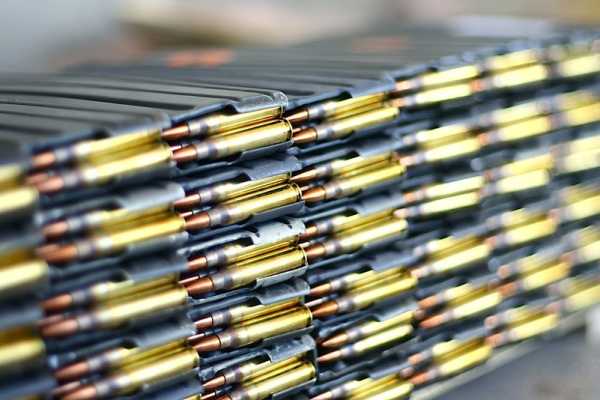
Europe’s weaknesses have become clear as the Ukraine war drags on. Despite national and joint incentives to boost domestic production, Europe's supply chains have fallen short of fulfilling the needs of the Ukrainian resistance (Photo: Yarden Sachs)
The EU’s internal market commissioner Thierry Breton is set to present next Tuesday (5 March) his much-touted (and repeatedly delayed) European Defence Industrial Strategy (EDIS), and accompanying European Defence Investment Programme (EDIP).
Together, these initiatives promise to advance the EU’s ambitions to foster a resilient defence industrial base, notably bolstering the continent’s production capacity of weapons and ammunition while incentivising cross-border cooperation.
Two years after the beginning of the Russian war of aggression in Ukraine, EDIS will be the latest addition to a growing list of EU announcements intended to ramp up the bloc’s credibility in all things industrial-defence.
The strategy is designed to provide an overarching, coherent framework to fill gaps in existing schemes and organise long-term production perspectives for the defence industry.
For that purpose, the European Commission has earmarked €1.5bn for the EDIP. The programme will build on previous instruments known as ASAP — Act in Support of Ammunition Production, and EDIRPA — European Defence Industry Reinforcement through Common Procurement Act — that will end in 2025.
European preference?
Europe’s weaknesses have become clear as the war drags on its doorstep. Despite national and joint incentives to boost domestic production, Europe’s supply chains have fallen short of fulfilling the needs of the Ukrainian resistance.
For instance, German defence minister Boris Pistorius warned that the EU’s target to deliver one million artillery shells to Ukraine by March 2024 will not be met.
In fact, since the beginning of the conflict, the EU committed €144bn financial support to Ukraine but was only able to allocate about half that, according to German think-thank Kiel. Most importantly, a significant share of that effective support is the result of purchases of ready-to-buy US supplies.
While the commission is yet to publish the strategy, parallels are drawn with the effectiveness of the US Defence Production Act, which leverages the president’s authority to prioritise domestic production and supply chains during times of crisis.
While an EU framework could only encourage interoperability and joint procurements, the political will for resilience is clearer.
Amid tense negotiations for the reform of the European Peace Facility, a tool used to reimburse bilateral donations to Ukraine, the French have become more vocal about a ‘European preference’ in defence purchases.
Indeed, supporting domestic capabilities would create a virtuous cycle of return on investment to build up the European industrial base and further withstand external security threats.
However, discrepancies between member states, notably Germany, highlight the lack of coordination among national industrial capabilities. The EDIS must bridge the gap to sustain emergency aid to Ukraine while developing long-term resilience.
In any case, this initiative has become more than timely for the readiness and stability of the continent.
Setting aside the Biden administration’s struggles for the adoption of the latest aid package for Ukraine, the forthcoming US presidential elections brings the looming risk of reduced military cooperation under a potential return of a Trumpist “America First” foreign policy.
EU defence commissioner?
The president of the European Commission, Ursula von der Leyen, is spearheading efforts to implement political changes aimed at revitalising the EU’s defence capabilities.
Contemplating another term in her position, von der Leyen has proposed the reorganisation of commissioners’ portfolios to appoint a dedicated Industrial Defence Europe chief, or so-called EU defence commissioner.
Speaking at the European Defence Agency in November, she emphasised the need to streamline market regulations to better accommodate the unique requirements of the defence industry through the EDIS.
“We need an updated regulatory framework, to give the industry and member states predictability and coherence on a continental scale,” she said.
Sign up for EUobserver’s daily newsletter
All the stories we publish, sent at 7.30 AM.
By signing up, you agree to our Terms of Use and Privacy Policy.
Indeed, European defence industries have voiced concerns regarding the consistency of public demand necessary to sustain a surge in production.
Delays in finalising public contracts are impeding the requisite investment to address urgent production needs.
Moreover, the reliance on long-term national commitments is precarious, given the potential for shifting political priorities, particularly in this election-heavy year of 2024.
In response to this challenge, French commissioner Breton has proposed establishing a new European defence fund totalling around €100bn to revamp the European defence industrial market.
“We need to be able to increase our capacity without perhaps having orders in place beforehand. We are ready to review their business model with them, including upfront investment to take a risk together to increase the industrial base’s capacity,” he said.
Yet, a critical question remains regarding the member states’ willingness to contribute such a significant amount.
While the EU executive would partly rely on the European Investment Bank and lessons learned from collective loans during the Covid-19 crisis, coordinated defence spending at EU level has often been hindered for an issue of competence in this domain.
Security and defence policy in the EU is indeed mainly a competence of the member states.
Source: euobserver.com